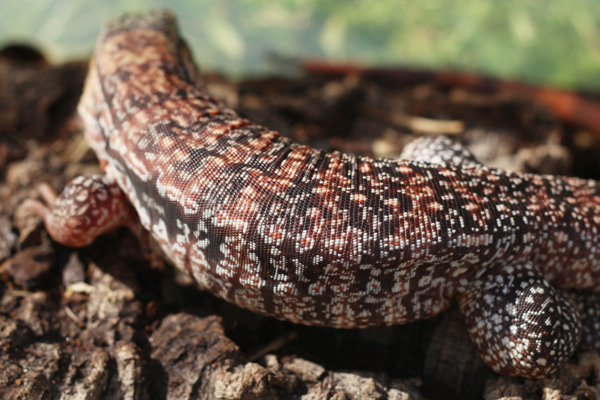It’s the ailment that scares nearly all reptile keepers the most. It worries us and sends us online to do hours of research on proper lights, hoods, and vitamin supplements. And we hear about it continuously in online groups or forums. MBD, MBD, MBD, over and over again. Unfortunately, it is one of the leading causes of unnecessary (and easily preventable) death in captive reptiles, and it hits young, growing animals particularly hard. What is it, how do we prevent it from happening to our pets, and how do we recognize if an animal has it?
What is MBD?
MBD is the
acronym for Metabolic Bone Disease,
which is a catch-all term for a condition in which (in summary) the body cannot
metabolize calcium properly and in severe cases leads to the bones of the body
becoming brittle and rubbery, and problems with muscles and the nervous system.
If it sounds painful it’s because it is; untreated, chameleons and other
reptiles with severe MBD will develop brittle bones that can break, bend out of
shape, and cannot support their movements. Chameleons can develop tremors
(hypocalcemic tetany), problems moving, lethargy, digestive issues, and
eventually death.
The good news is that is is preventable, early all cases of MBD could have been easily
avoided. It is like heartworm in dogs; extremely easy to prevent but serious
once the infestation has set in. Thankfully, MBD is also treatable and although
broken or misshaped bones may never heal and look completely normal, the bone density
can be corrected and the body brought back into balance.
What Causes MBD?
There are a few other rare causes, but for nearly all cases
of MBD this is where the blame lies:
 |
| MBD in the tail of a Meller's chameleon. |
It is vital that chameleons have a linear (tube style)
fluorescent UVB bulb across the cage, on 10-12 hours a day, so they can bask
and produce their own vitamin D. Some good bulbs to consider are the Reptisun
5.0 or 10.0 or the Arcadia 6% or 12% lights, as examples (the new high-output
T5 bulbs are better, but the T8 are fine). Each bulb will have a
different life span of UV radiation, but they should be replaced every 6-12
months depending on the brand, to ensure that they are always going strong. And make sure that the fixtures never have a plastic cover, as UVB cannot go through glass or plastic.
SUPPLEMENTS: The
second major cause is improper supplementation. I’ve written at length about
what Vitamins and Minerals Do (and Why They Matter) and on Which Supplement is Best and Why, but as a
quick summary this is the stuff to know:
Calcium is (as we all know) absolutely necessary to build
strong bones. A lot of the insects we feed are not very high in calcium so we
find it necessary to correct this by dusting feeders lightly with calcium
powder. Occasionally a calcium or
multivitamin containing artificial vitamin D3 can be given, to fill in any
potentially gaps the UVB bulb may not be covering. Here, people tend to make
one of two mistakes:
Either their give too little calcium at all or they give way too much vitamin D3
Either their give too little calcium at all or they give way too much vitamin D3
But Olimpia, you’re thinking, that makes no sense. Didn’t
you just say vitamin D is important? Yes, dear reader! But the skin can make as
much or as little vit D as it needs, whereas oral supplement vit D is (in short)
fat-soluble and will build up in the body, with nowhere useful to go. Too much
and it actually starts to work against us – getting in the way of
absorbing calcium, calcifying the soft tissues, and causing MBD too. So
to keep this short and sweet; a little vitamin D3 in the diet is a great idea,
but too much (ie. daily) will lead to complications.
A little goes a long way with vitamin D! With most brands 2-4 times a month will do, depending on your chameleon species.
A little goes a long way with vitamin D! With most brands 2-4 times a month will do, depending on your chameleon species.
What Are Some Symptoms of MBD?
 |
| Veiled chameleons with MBD. Broken arms, malformed casques, etc. are all physical signs. |
Soft bones, breaks, and asymmetry in the bones are all
physical signs. The bones in the arms and legs should be nice and straight with
a single elbow/knee join. Two or three “elbows” in an arm mean that the bone
has broken in a couple places. The edges of the mouth should be straight. The
spine and tail should be nice and straight also with no serpentine curves.
Other physical signs include tremors and clumsiness. Remember how calcium is used in the
muscles? Without enough calcium to work properly you’ll start to see signs like
muscle tremors in the arms and legs, particularly when walking, trouble moving
around normally, lethargy, problems shooting the tongue at food, and even
constipation.
 |
| What a healthy young veiled (female) should look like. |
 |
| Another healthy veiled chameleon female. Nice straight limbs, straight casque, and straight spine. |
How Can MBD Be Treated? Is it Curable?
The first step in treatment is to reach out
to a vet for assistance. Depending on what the root cause is, changes to the
cage and/or diet will definitely need to be made. But a veterinarian can give
an injection of calcium to start recovery and can help you with the correct
dosage of an oral liquid calcium (if necessary) for as part of treatment. I
highly discourage anyone from administering medicines at home without the
guidance of a professional, even though liquid calciums like calcium glubionate
are easily available online. You want to return the body to a state of balance
carefully, properly, and slowly, so not over-doing it is important as well.
It is possible to stop MBD, return the
blood calcium levels to where they should be, and re-solidify the bones again.
However the breaks and curvatures in the bones may never correct themselves
entirely (so the animal may always be somewhat malformed) and it’s difficult to
determine how much permanent organ damage may have occurred. But with
veterinary assistance and changes to husbandry, animals suffering from MBD can
be treated and go on to live normal or nearly-normal lives for some time.
In severe cases where moving around is difficult or dangerous for the animal, a hospital cage might be necessary. To learn how to make a hospital cage, check out my article for Reptile Apartment, How To Make a Chameleon Hospital Cage.
In severe cases where moving around is difficult or dangerous for the animal, a hospital cage might be necessary. To learn how to make a hospital cage, check out my article for Reptile Apartment, How To Make a Chameleon Hospital Cage.
How Do I Prevent MBD?
Metabolic bone disease is an easily preventable disease, and by taking just a few steps can be avoided entirely. And as always, if you still have questions please don't hesitate to ask!













You would do well to mention that direct sunlight is critical for juveniles, particularly in their first year of life. I met the above the requirements with my lighting and suppliments, and it wasn't enough. Direct sunlight is invaluable. At least 30 min a day
ReplyDeleteHi Jennifer, thanks for the comment! I whole-heartedly agree that if you can supplement with natural sunshine, at least on the weekends, it can have tremendous benefits for chameleons. I read a study once that I’ve never been able to find again so I can’t cite it, but they exposed green iguanas to natural sunshine after absolutely no UV and the amount of vitamin D produced in the skin after just 20 minutes of exposure could still be detected in the blood 2 weeks later. That’s powerful! None of our artificial lights can put out that kind of production power.
DeleteHowever, thousands of chameleons are raised exclusively on artificial lighting and supplements and grow up to be healthy adults, and even scientific standards for the correct housing of chameleons in laboratory settings outline the use of just supplements and lighting because it works to raise healthy chameleons. Like I said above, if this wasn’t enough in your case then there had to be some reason that put your chameleon(s) was that 1% of cases where MBD isn’t a supplement/lighting issue (if, we assume you didn’t purchase a lemon UVB light or anything like that.) I saw recently a ball python necropsy that showed the poor snake had terrible MBD. Very strange, because BP don’t usually suffer from MBD! The vet found that his intestines were really irritated and swollen, so she concluded that whatever had caused the swelling (maybe an infection, injury, etc.) was causing his GI tract lining to be totally unable to digest any nutrients. Including calcium, so his bones were thin and brittle. That’s definitely one of those “outlier” cases that account for rare cases of MBD.
If someone has the climate to get their chameleons outside regularly (or at least on the weekends) then definitely, I strongly encourage that! But a high-quality UVB bulb and the right balance of supplemental mineral/vitamin products (on top of a good diet) should be enough to raise healthy chameleons to adulthood.
This comment has been removed by the author.
ReplyDeleteเล่นสล็อตออนไลน์แล้วรวย
ReplyDeleteต้องเข้ามาเล่นที่เว็บนี้ live22 ฟรีเครดิต
https://www.slotxd.com/live22